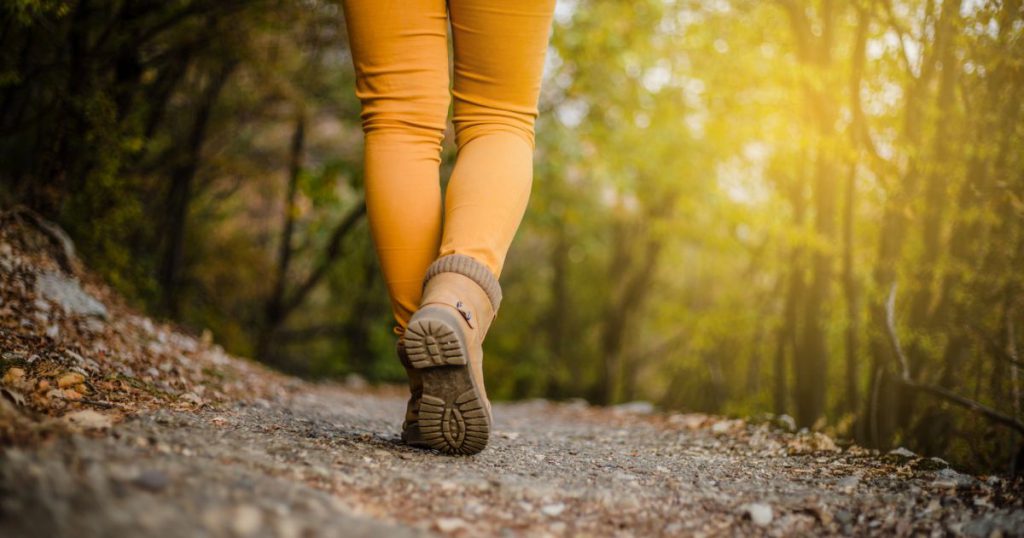Trauma can have a profound impact on a person’s physical and mental health, particularly for us women who are experiencing trauma related to involuntary childlessness. In this blog, I will explore the benefits of walking in the process of releasing trauma and promoting healing and the physical and mental benefits of walking, as well as the unique benefits that it offers for women who are childless not by choice.
As human beings, we are capable of experiencing a wide range of emotions. Some of these emotions can be positive, such as joy, happiness, and love, while others can be negative, such as fear, anxiety, and sadness.
Trauma is one of the most significant negative emotions that can impact us in profound ways. Trauma can cause long-lasting effects that can manifest as anxiety, depression, and PTSD.
The thing is that many people are not aware that being involuntarily childless can cause trauma and even lead to symptoms of post-traumatic stress disorder (PTSD). There are a few reasons why this may be the case:
- Lack of understanding: Many people may not understand the emotional impact of infertility or the struggles of those who are involuntarily childless. Without a personal connection to the issue, it can be difficult for them to understand the pain and trauma that it can cause.
- Stigma and shame: Infertility and involuntary childlessness are still viewed as taboo or shameful topics. This can lead to a lack of awareness and understanding of the struggles that individuals and couples face.
- Lack of education: Despite the fact that infertility and involuntary childlessness are relatively common issues, there is still a lack of education and awareness around these topics. This can make it difficult for people to recognize the signs of trauma or PTSD in themselves or others.
- Limited research: While there is growing recognition of the emotional impact of infertility and involuntary childlessness, there is still relatively little research on the topic. This can make it difficult to fully understand the extent of the trauma that it can cause and the most effective ways to address it.
That’s why it has been so important to me to raise awareness around the trauma of infertility. And also create a deeper understanding of the trauma and PTSD that can result from being involuntarily childless. This can help us receive the support and resources we need to heal and move forward.
The trauma of infertility can impact our bodies in numerous ways. It can affect our sleep, our digestion, and our overall physical health. Trauma can also leave us feeling stuck, unable to move forward from the experience.
However, movement and exercise can help release trauma and promote healing. Walking, in particular, can be a useful tool in releasing trauma.

The Unique Benefits of Walking for Women with Trauma Related to Involuntary Childlessness
Walking is a simple and accessible form of exercise that has numerous benefits for our physical and mental health. It has shown to reduce stress, anxiety, and depression while improving our overall sense of well-being. Walking can also promote the release of endorphins, which are our body’s natural feel-good chemicals. When we engage in physical activity, our body produces endorphins that can help us feel better, both physically and emotionally.
I have struggled with PTSD symptoms following a traumatic experience several years ago. I found that traditional therapy methods were not helping me to manage my symptoms effectively. However, when I started incorporating daily walks into my routine, I noticed a significant reduction in my symptoms. I found that the rhythm of walking helped to calm my mind and reduce my anxiety. Being in nature provided a sense of peace and tranquility that I had not experienced in a long time.
Research studies have shown that regular walking can have a positive impact on symptoms of PTSD. A 2018 study in the Journal of Traumatic Stress showed walking helps improve PTSD and depression symptoms in veterans. In 2020, a study published in Frontiers in Psychology found walking in nature effectively reduces anxiety and depression symptoms in individuals with PTSD.
A dear friend of mine, let’s call her Marianne, a woman in her late 40s has been struggling with the emotional pain of involuntary childlessness for many years. She found that talking to friends and family about her struggles was helpful, but she still felt a sense of emptiness and sadness that she could not shake. Marianne started going for long walks in the park. She found that the physical activity helped to release build-up emotions, and reduced her stress levels. She also found that being surrounded by nature helped to put her problems into perspective and gave her a sense of hope for the future.
Research studies have shown that physical activity, including walking, can improve emotional well-being and reduce stress. The Journal of Affective Disorders published a study in 2018 that associated exercise, including walking, with a reduction in symptoms of depression and anxiety. Similarly, a 2016 study published in the Journal of Health Psychology found that walking in nature was linked to decreased rumination and improved mood.
And I’m not done yet. In 2016, the Journal of Affective Disorders published a study. The study found that walking reduced symptoms of depression and anxiety in trauma survivors. Walking positively impacted the brain’s prefrontal cortex, which is responsible for regulating our emotions.
Walking allows us to connect with our bodies and our emotions in a gentle and supportive way. It can also help us feel more connected to our environment and the world around us. Walking can be a form of meditation, allowing us to quiet our minds and focus on the present moment.
Incorporating Walking into Your Healing Journey
If you are experiencing trauma, incorporating walking into your daily routine can be an effective way to promote healing. Start by setting a small goal, such as walking for 10 minutes each day. Gradually increase the amount of time you spend walking as your body becomes more accustomed to the activity. You can also incorporate mindfulness practices into your walking routine, such as focusing on your breath or noticing the sensations in your body as you walk.
Trauma can have a profound impact on our physical and mental health. Walking and movement can be powerful tools in releasing trauma and promoting healing. Walking is a simple and accessible form of exercise that has numerous benefits for our overall well-being.
In addition to the physical and mental benefits of walking, there are other benefits as well. Walking allows us to get outside and connect with nature, which can have a calming effect on the mind and body. It can also provide us with a sense of accomplishment and self-efficacy, which can help boost our self-esteem and confidence! Don’t we all need that in the midst of redefining ourselves?

Seeking Additional Support for Trauma
Incorporating walking into your daily routine can be an effective way to manage the symptoms of trauma and promote healing. However, it is important to remember that walking is just one tool in a larger toolbox. Therapy, medication, and other forms of treatment can also be helpful in managing the symptoms of trauma and promoting healing. Healing from trauma is a journey, and it is essential to be patient and compassionate with yourself along the way.
If you are interested in learning more about walking to release any stored trauma, here are some additional resources.
- “The Body Keeps the Score: Brain, Mind, and Body in the Healing of Trauma” by Bessel van der Kolk. This book is a comprehensive guide to understanding trauma and its effects on the body and mind. It includes information on the benefits of movement and exercise for healing.
- Trauma-Informed Yoga: A gentle form of yoga that is designed to support individuals who have experienced trauma. While yoga is different from walking, it is another form of movement that can be helpful for releasing trauma.
- Sidewalk Talk: Sidewalk Talk is a community listening project that provides free listening and support services in public spaces. It is a great resource for individuals who are seeking connection and support. Or download the Happy & Childless app to connect with like minded childless people.
- The National Center for PTSD: The National Center for PTSD provides resources on trauma and PTSD. It includes a section on self-care and coping strategies. It provides information on the benefits of exercise for managing trauma symptoms.
- Support groups: Many communities have support groups for individuals who have experienced trauma or who are dealing with specific challenges, such as infertility or childlessness. These groups can be a great way to connect with others who have had similar experiences and learn about coping strategies that have worked for others. Ask me if you want to know more!
These resources are just a few examples of the many options available. It is important to find the resources that work best for your specific needs and to seek out support from professionals if needed.

Taking Your Healing Journey to the Next Level: Walking & Hiking Retreats
Are you interested in taking your healing journey a step further? I invite you to connect with me to learn more about the walking & hiking retreats that I organise for women who are involuntarily childless. These retreats are designed to provide a supportive and nurturing environment for women to connect with nature, engage in physical activity, and connect with others who are on a similar healing journey. Together, we can take steps towards healing and (in your own time!) move beyond childlessness.
One small step can start a ripple effect of positive change in your life.
If you’re looking for an opportunity to reset, reconnect, and refocus in the company of like-minded women who understand the challenges of infertility and childlessness, I invite you to join our monthly CNBC Circle (it’s FREE!) Sign up here!


